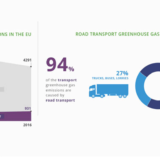European Commission proposes new CO2 emission targets
The European Commission has proposed new targets for the EU fleet-wide average CO2 emissions of new passenger cars and vans that will apply from 2025 and 2030 respectively, to help accelerate the transition to low- and zero emission vehicles in the European Union. Both for new cars and vans, the average CO2 emissions will have to be 30% lower in 2030, compared to 2021.
ACEA, which represents the 14 Europe-based car, van, truck and bus manufacturers, said it welcomes the fact that the date for the new targets has been set for 2030. “This is consistent with the timings already agreed by the EU heads of states with the 2030 Climate and Energy Framework,” ACEA Secretary General Erik Jonnaert said.
“However, setting an additional target already in 2025 – just a few years after the 2021 targets – does not leave enough time to make the necessary technical and design changes to vehicles, in particular to light commercial vehicles given their longer development and production cycles.”
“Clearly, CO2 targets can provide an impetus for innovation in the auto industry, but the current proposal is very aggressive when we consider the low and fragmented market penetration of alternatively-powered vehicles across Europe to date,” he said. In the third quarter, ACEA reported that alternatively powered cars accounted for only 6.2% of total passenger car sales, or 211,635, in the EU. Electrically chargeable vehicles (ECVs) made up 1.6% of all cars sold across the EU.
“The 30% reduction level proposed by the Commission is also overly challenging, going beyond the ambition level set out in the Climate and Energy Framework and in its own 2016 impact assessment, which specifies what is needed to deliver on COP21. In line with this, the European auto industry considers a 20% reduction by 2030 for cars to be achievable at a high, but acceptable, cost,” ACEA’s Jonnaert said.
The European Commission said that the proposed CO2 emission reduction targets are based on “sound analysis and broad stakeholder involvement, from NGOs to industry.”
“The EU must seize this opportunity and become a global leader, with countries such as the United States and China moving ahead very quickly. To give one example: EU sales of new passenger cars relative to global sales have decreased from 34% before the financial crisis (2008/2009) to 20% today,” the commission said in a statement.
“The proposal establishes ambitious, realistic and enforceable rules to help secure a level playing field between actors in the industry operating in Europe. The package will also put in place a clear direction of travel towards achieving the EU’s agreed commitments under the Paris Agreement and will stimulate both innovation in new technologies and business models, and a more efficient use of all modes for the transport of goods.”
The Clean Mobility Package proposal from the European Commission, the European Union’s executive body, includes the following documents:
– New CO2 standards to help manufacturers to embrace innovation and supply low-emission vehicles to the market. The proposal also includes targets both for 2025 and 2030. The 2025 intermediary target ensures that investments kick-start immediately. The 2030 target gives stability and long-term direction to keep up these investments. These targets will help push the transition from conventional combustion-engine vehicles to clean ones.
– The Clean Vehicles Directive to promote clean mobility solutions in public procurement tenders and thereby provide a solid boost to the demand and to the further deployment of clean mobility solutions.
– An action plan and investment solutions for the trans-European deployment of alternative fuels infrastructure. The aim is to increase the level of ambition of national plans, to increase investment, and improve consumer acceptance.
– The revision of the Combined Transport Directive, which promotes the combined use of different modes for freight transport (e.g. lorries and trains), will make it easier for companies to claim incentives and therefore stimulate the combined use of trucks and trains, barges or ships for the transport of goods.
– The Directive on Passenger Coach Services, to stimulate the development of bus connections over long distances across Europe and offer alternative options to the use of private cars, will contribute to further reducing transport emissions and road congestion. This will offer additional, better quality and more affordable mobility options, particularly for people on low income.
– The battery initiative has strategic importance to the EU’s integrated industrial policy so that the vehicles and other mobility solutions of tomorrow and their components will be invented and produced in the EU.
The Clean Mobility proposals will be sent to co-legislators for their approval. The Commission called “on all stakeholders to work closely together to ensure the swift adoption and implementation of these different proposals and measures, so that the benefits for the EU’s industry, businesses, workers and citizens can be maximised and generated as soon as possible.”





.png)





